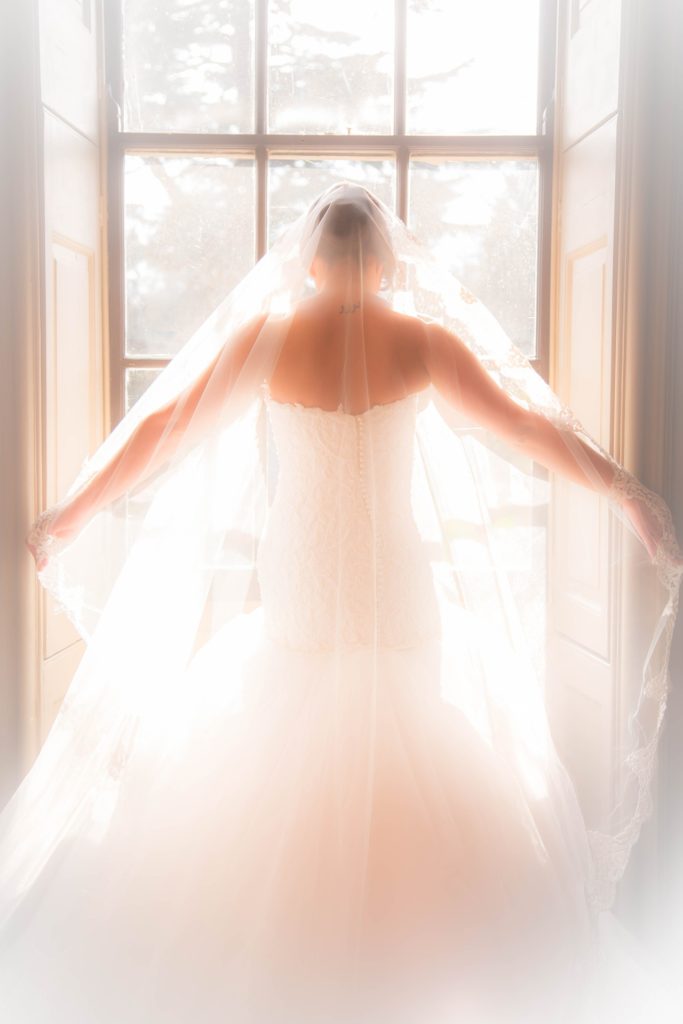Tips for Storing Gowns
Don’t hang a wedding gown over a prolonged period or it will stretch and sag.
Don’t seal fragile gowns in plastic bags. Moisture forms inside and promotes mildew and fabric rot.
Don’t expose gowns to strong light or open air. Dust, dirt and sunlight cause deterioration.
Air and the bacteria in the air will turn your wedding gown yellow in a very short time. Be sure that you have it professionally clean within 60 day of the wedding.
Care and knowledge are the key to Santoro’s success in preserving your wedding gown. Wedding gowns may have different price tags, but all gowns have a large degree of sentimental value.
FABRIC FACTS— A wedding gown is one of the most important and cherished articles of clothing selected by a customer. People attempt to preserve wedding gowns for the joy of remembrance and the possibility of passing the gown on for future use to members of the family. The styles of wedding gowns have undergone some fashion changes but not
dramatically. The wedding gown relies on lace and ornamental trimming such as beads, sequins, pearls and droplets to emphasis their uniqueness. The color is traditionally white but can range from pure white to beige, ivory of white and ecru. A wedding gown fabric is usually taffeta, satin and occasionally velvet or crepe is used. The fibers commonly used for wedding gown are acetate, polyester, nylon, rayon, cotton and silk.
FABRIC PROBLEMS—Many wedding gowns are NOT labeled with care instructions nor are they styled for serviceability. The problems with wedding gowns may be due to, Aged and oxidized stains that cause yellowing and weakened areas due to improper storage.
It is important to determine how trim has been applied to the gown. Many beads, laces, feather, and other trims may be attached with glue. If the trim has been glued to the gown, the glue should be tested to see if it will withstand the solvents used in cleaning. We apply a generous amount of solvent to a glued area, if the glue soften or becomes tacky, the glue will most likely dissolve in the dry-cleaning procedure, resulting in the loss of the trim.
TRIM —The trim itself should also be tested for resistance to solvent. Many beads contain polystyrene, which is soluble in some solvents. In some cases, only the core of the bead is constructed of polystyrene and testing the beads is not always indicative of the beads’ performance in dry-cleaning: core beads deteriorate from the center of the core and damage is not always evident with a cursory test. A gown may have many different beads that will require testing.
Sequins should also be tested for resistances to the chosen care process. Many sequins possess a metallic or colored coating which may be removed when immersed in the solvent. To test sequins, apply a small amount of solvent to an inconspicuous area of sequins and rub briskly. If the sequin color or reflectance is altered by the test, the sequins will not withstand the effects of solvent.
If a problem becomes apparent after an evaluation of all components of the garment, we (the cleaner) will call the customer and discuss the gown and any alternatives that must be taken. If there are any doubts about the garment’s ability to withstand the advised care process, it is suggested a customer consent form be filled out and the customer be made aware of risks involved in cleaning the article. Some problems are unforeseen in cleaning wedding gowns. However, thorough testing and examination will eliminate most alarming discoveries of damage after a care process.
PRESPOTTING—All gowns received for cleaning and pressing at Santoro’s are hand examined, by the owner of our company, Gaetano Santoro. Every wedding gown is prespotted before the initial care process to decrease the amount of agitation necessary to clean the garment during dry-cleaning(or wetcleaning). Hemlines are usually heavily soiled and require prespotting. Prespotting also is necessary to remove stains such as blood, albumin, sugar, beverage and food stains that are typically found on a gown and can be removed easier in local spotting.
FINISHING—After final inspection, Santoro’s hand finishes all our wedding gowns. The gown is then hung to air out in order to remove any extra moisture from finishing.
PRESERVATION—After your gown is cleaned and free of stains, it is carefully prepared for storage in our acid free preservation chest.
Acid-Free Paper—Acid-free papers are made without alum. Synthetic sizing as well as dyes and pigments, which required no acid fixatives, are used. Furthermore, the paper can be treated without alkaline buffering agents, such as calcium carbonate, to neutralize any atmospheric pollution.

